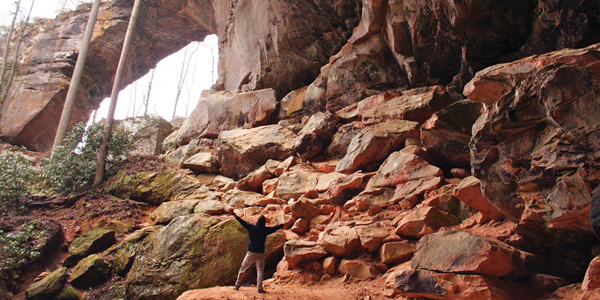Forget climbing, the Red River Gorge is a paradise for hikers. This is your guide to making the most of your time in the Red, whether you’re looking for a scenic cruise in your car or a weekend-long backpacking excursion.
Lay of the Land
The Red River Gorge Geological Area sits inside the Daniel Boone National Forest, less than an hour east of Lexington. The Big South Fork National Recreation Area is to the south and Breaks Interstate Park is to the east.
The Red isn’t a single gorge, it’s a maze of narrow ridges and valleys separated by steep slopes and sandstone cliffs.
“The terrain is steep and navigation is really tough in the gorge, even if you know the area well. When you get into one of those hollows, it’s easy to get turned around,” says Stephanie Ross, a climber and adventure racer who has been exploring the gorge for years. The trails are impeccably maintained and signed, thanks to the Red River Gorge Trail Crew. But getting off trail in the Red is half the fun, since there’s rock every- where you look. Giant boulders, 200-foot cliffs, caves, and arches are often hidden right behind a layer of rhodo as you pass by on the trail.
Scenic backcountry roads form a loop through the gorge, making trailhead access quick and easy, and the Coombs Mountain Parkway is a four-lane road leading right to the Red’s front door.
Start Here: Slade, Ky. There’s not much to the town of Slade, which has as many go-cart tracks as it does restaurants, but the small burg serves as the hub of all things Red. Before you start exploring, pick up a set of maps ($16) at the Shell Station, the unofficial welcome center to the gorge. They’re waterproof with all the topo info and hiking details you’ll need. When you’re finished with a long day of trekking the steep slopes of the Red, grab a slice of pie at the world-famous Miguel’s Pizza (606-663-1975).
Why so many arches? The cliffs in the Red River Gorge are made up of tough sandstone and a shale deposited from the erosion of the Appalachian Mountains 300 million years ago. Over time, streams cut through the area eroding the shale, but leaving the harder sandstone intact. After millions of years of water and wind, we’re left with the strikingly smooth, bizarre arches we see today. According to the Natural Arch and Bridge Society, Kentucky likely has the second highest number of arches in the country, behind Utah and ahead of Arizona. Many of those arches are in the Red.








